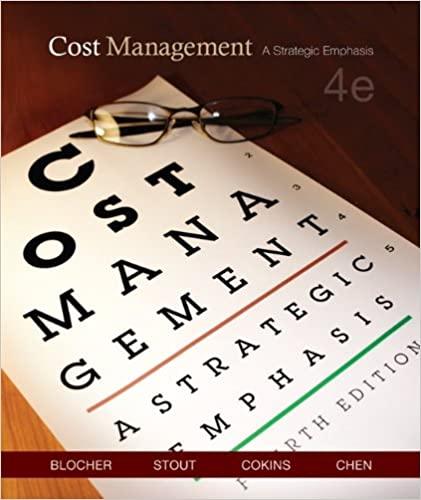Question
Brothers Mike and Tim Hargen began operations of their tool and die shop (H & H Tool, Inc.) on January 1, 2016. The annual reporting
Brothers Mike and Tim Hargen began operations of their tool and die shop (H & H Tool, Inc.) on January 1, 2016. The annual reporting period ends December 31. The trial balance on January 1, 2017, follows:
| Account Titles | Debit | Credit | |||||
| Cash | 6,000 | ||||||
| Accounts receivable | 5,000 | ||||||
| Supplies | 14,000 | ||||||
| Land | |||||||
| Equipment | 81,000 | ||||||
| Accumulated depreciation (on equipment) | 11,000 | ||||||
| Other assets (not detailed to simplify) | 10,000 | ||||||
| Accounts payable | |||||||
| Wages payable | |||||||
| Interest payable | |||||||
| Income taxes payable | |||||||
| Long-term notes payable | |||||||
| Common stock (8,000 shares, $.50 par value) | 4,000 | ||||||
| Additional paid-in capital | 83,000 | ||||||
| Retained earnings | 18,000 | ||||||
| Service revenue | |||||||
| Depreciation expense | |||||||
| Supplies expense | |||||||
| Wages expense | |||||||
| Interest expense | |||||||
| Income tax expense | |||||||
| Remaining expenses (not detailed to simplify) | |||||||
| Totals | 116,000 | 116,000 | |||||
Transactions during 2017 follow:
Borrowed $15,000 cash on a 5-year, 8 percent note payable, dated March 1, 2017.
Purchased land for a future building site on March 15, 2017; paid cash, $14,000.
Earned $239,000 in revenue. Transactions dated August 30, 2017 , including $52,000 on credit and the rest in cash.
Sold 4,000 additional shares of capital stock for cash at $1 market value per share on January 1, 2017.
Incurred $120,000 in remaining expenses for 2017, invoices dated October 15, 2017, including $23,000 on credit and the rest paid in cash.
Collected accounts receivables on November 10, 2017, $37,000.
Purchased other assets on November 15, 2017, $14,000 cash.
Purchased supplies on account for future use on December 1, 2017, $26,000.
Paid accounts payable on December 15, 2017, $24,000.
Signed a three-year $32,000 service contract on December 17, 2017 to start February 1, 2018.
Declared and paid cash dividends on December 20, 2017, $24,000.
Data for adjusting entries:
Supplies counted on December 31, 2017, $17,000.
Depreciation for the year on the equipment, $13,000.
Interest accrued on notes payable (to be computed).
Wages earned by employees since the December 24 payroll but not yet paid, $16,000.
Income tax expense, $12,000, payable in 2018.
General Journal tab - (Step 1) Prepare the journal entries to record the transactions (1) through (11). Review the accounts as shown in the General Ledger and Trial Balance tabs. (Step 2) Prepare the necessary adjusting entries (12) through (16) to correctly report net income for the period. (Step 3) After preparing the financial statements, record the closing entry (17). Notice the effect on the trial balance, income statement, and balance sheet tabs once the closing entry is posted.
General Ledger tab - Each journal entry is posted automatically to the General Ledger. Use the drop-down button to view the unadjusted, adjusted, or post-closing balances in the General Ledger.
Trial Balance tab - You may view either the unadjusted, adjusted, or post-closing trial balance by choosing from the drop-down. Your choice will determine the reported values on the financial statement tabs.
Income Statement tab - Use the drop-downs to select the accounts that should be properly included on the Income Statement. Compute earnings per share. The unadjusted, adjusted, or post-closing balances will appear for each account, based on your selection.
Statement of Stockholders' Equity tab - Use the drop-downs to select the accounts that should be properly included on the Statement of Stockholders' Equity and enter the appropriate amounts.
Balance Sheet tab - Use the drop-downs to select the accounts that should be properly included on the Balance Sheet. The unadjusted, adjusted, or post-closing balances will appear for each account, based on your selection.
Statement of Cash Flows tab - For each transaction, identify the appropriate cash flow classification (if any) and the transaction's impact on cash.
Analysis tab - Calculate the current ratio, total asset turnover ratio, and net profit margin ratio for 2017.
Step by Step Solution
There are 3 Steps involved in it
Step: 1

Get Instant Access to Expert-Tailored Solutions
See step-by-step solutions with expert insights and AI powered tools for academic success
Step: 2

Step: 3

Ace Your Homework with AI
Get the answers you need in no time with our AI-driven, step-by-step assistance
Get Started


